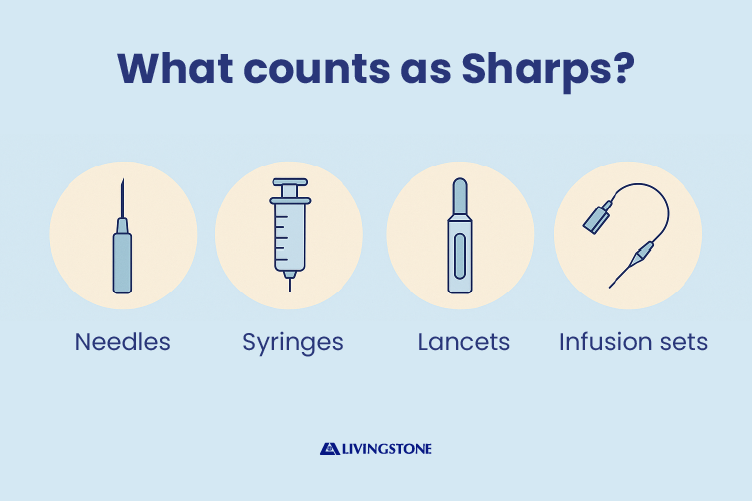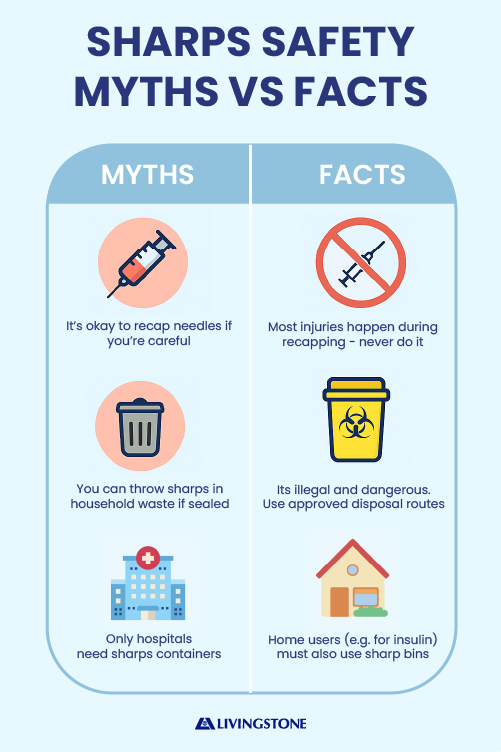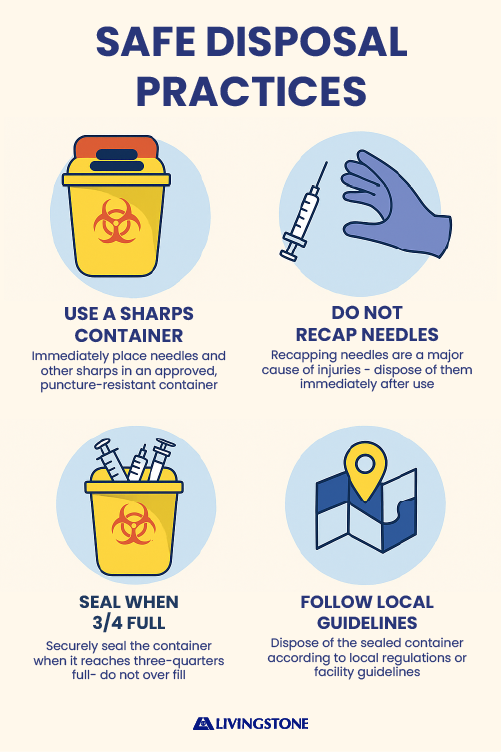Each year in Australia, over 18,000 healthcare workers experience needlestick injuries, many of which are preventable with proper sharps waste container use and safe handling practices[1]. In public spaces, discarded sharps endanger sanitation workers, council staff, and the broader community.

Whether in hospitals, aged care homes, or private residences, effective sharps management is essential for maintaining hygiene, reducing injury risk, and meeting workplace safety standards. A properly used sharps waste container plays a critical role in protecting both healthcare professionals and the public.
Why Sharps Waste Containers Are Essential for Safety
Sharps waste must never be discarded in regular rubbish bins or left exposed in the environment. Doing so significantly increases the risk of injury, particularly needlestick injuries, which can expose individuals to viruses such as hepatitis B, hepatitis C, and HIV.
Sharps waste containers are specially designed to mitigate these risks. They are typically made of rigid, puncture-resistant plastic with a secure, leak-proof lid. These containers are marked with biohazard labels and come in various sizes for different care environments.
The Dangers of Recapping Needles
One of the most common and dangerous practices in sharps handling is recapping a used needle. While it may seem harmless, this action is one of the leading causes of accidental needlestick injuries. The brief moment it takes to guide the cap back onto a needle is enough time for a misstep, and the consequences can be serious.

Healthcare guidelines across Australia and internationally are clear: needles must never be recapped after use. Doing so significantly increases the risk of accidental needlestick injuries, which can expose healthcare workers to serious infections. Instead, used needles should be disposed of immediately into an approved sharps waste container placed within arm’s reach during procedures. This practice is supported by organisations such as the World Health Organisation (WHO), which highlights the importance of safe injection practices and proper sharps disposal in reducing occupational injuries. For further details, WHO’s Injection Safety Fact Sheet outlines global standards for needlestick injury prevention and container use. Proper Use and Placement of Sharps Containers[2].
Safe sharps disposal starts with accessibility. Sharps containers should be:
- Positioned as close as possible to the point of use
- Mounted at eye level and within arm’s reach
- Secured to prevent tipping or tampering
- Clearly labelled with a biohazard symbol
Once the container reaches the fill line, which is typically marked around 75 to 80% full, it should be sealed and replaced. Overfilled containers are more likely to pose a risk, as sharps may protrude or cause the lid to fail.
In clinical environments, filled containers are collected by licensed medical waste services. At home, many pharmacies and local councils provide community sharps disposal options.
For disposal guidance in Australia, visit NSW Health’s Community Sharps Program, which offers information on safe return locations by postcode[3].
Disposing of Sharps Containers and Related Items

Disposal does not end when the container is sealed. Knowing how and where to dispose of sharps containers is essential for regulatory compliance and community safety.
Depending on your location, full containers can be returned to:
- Participating pharmacies
- Local council sharps drop-off sites
- Public health units or clinics
- Licensed sharps collection services
In many cases, empty medication vials made of glass should also be placed in sharps containers to prevent breakage and injury. Plastic vials or ampoules may be treated as general clinical waste. Always consult your facility’s waste policy or local authority guidelines to determine the correct method of disposal.
Medical Waste Disposal Beyond Sharps
Sharps are only one type of regulated medical waste. Healthcare facilities and carers also need to manage:
- Infectious waste, which includes blood-soaked items or contaminated materials
- Pharmaceutical waste, including expired or unused medications
- Pathological waste, such as human tissue and bodily fluids
- General clinical waste, like gloves, IV tubing, and gauze
Each category requires its own method of segregation, containment, and disposal. Using colour-coded bins and labels helps prevent cross-contamination and ensures compliance with infection control protocols.
Staff training and regular audits are essential. Everyone involved in waste handling should understand the difference between waste types and how to dispose of each one properly.
Sharps containers are a vital part of healthcare and home care safety. When used correctly, they help reduce the risk of needlestick injuries, maintain infection control standards, and support legal compliance in waste management.
Practices like recapping needles, tossing sharps into general rubbish bins, or delaying disposal are easily avoided through education and routine. By staying informed and following safe disposal practices, healthcare professionals, carers, and family members can protect themselves and others from preventable harm.
For organisations, investing in proper disposal systems and regular staff education is not only best practice but also a demonstration of care and responsibility.
References
- Ausmed, 2023. Needlestick Injuries in the Workplace. [online] Ausmed Education. Available at: https://www.ausmed.com.au/learn/articles/needlestick-injuries-in-the-workplace [Accessed 1 May 2025].
- Ausmed, 2023. Needlestick Injuries in the Workplace. [online] Ausmed Education. Available at: https://www.ausmed.com.au/learn/articles/needlestick-injuries-in-the-workplace [Accessed 1 May 2025].
- Ausmed, 2023. Needlestick Injuries in the Workplace. [online] Ausmed Education. Available at: https://www.ausmed.com.au/learn/articles/needlestick-injuries-in-the-workplace [Accessed 1 May 2025].
